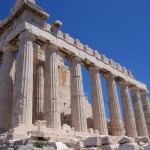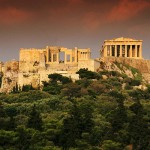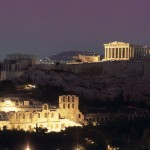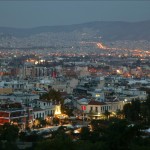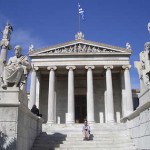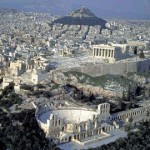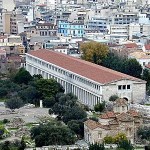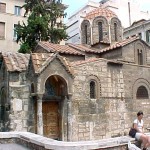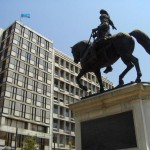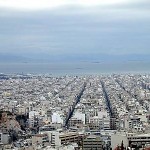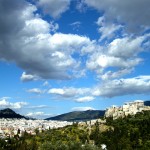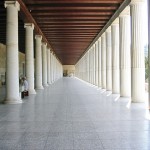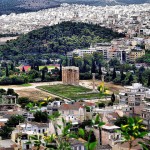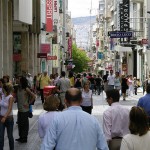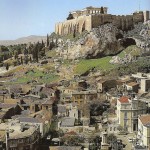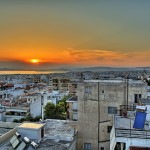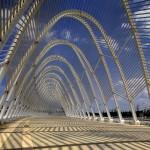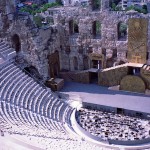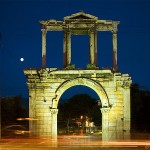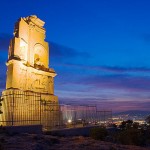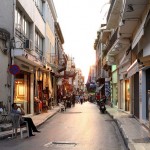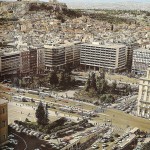DR. Shahid Qayyum writes about the amazing life in Greece:
Athens, named after the Greek goddess Athena, has been a popular destination for travelers since antiquity. This bustling cosmopolitan city is one of the oldest in the world with a recorded history of over 3000 years of inhabitation. My recognition of Greece dates back to the early childhood days when I read the story of Alexander the Great, the Macedonian prince, who tamed the famous strong headed stallion as a young boy and later set out to conquer the world. In fact it was only after Alexander assumed power that the city state of Athens and the neighboring principalities conglomerated to form the country now called Greece. Alexander brought Greek ideas, culture and life style to the countries that he conquered and the marks he left behind during his conquest of the subcontinent are amply visible in Taxila which I happened to visit as a school boy.
I was lucky to visit Greece more than a couple of times and every time it was an experience of sorts, as the places transform for the better over the years. The first time that I visited the Balkan Peninsula was in the mid 1970s. It was the month of April and it was pleasantly cold out there in the open. We were told the metropolis had its first snowfall in forty years which was still visible on the top of Mount Lycabettus, in central Athens. The subsequent visits years later, in the months of July and August, were different in the way that summers had set in and the day time temperatures were some what uncomfortable. It was hot according to the European standards. Located between Mediterranean and Alpine climatic zones the city enjoys typical Mediterranean climate. The northern mountainous suburbs are usually cooler than the southern tip surrounded by the sea.
Ancient Athens was a powerful city state and a centre for arts and philosophy. It was known as the cradle of Western civilization and birth place of democracy. The heritage of classical era is portrayed through a number of ancient monuments and art works, the most famous being Parthenon and Acropolis, standing as the epic land marks. There are a vast variety of Roman and Byzantine monuments as well, the Temple of Olympian Zeus and Hadrian’s Arc to name a few. All these monuments are located within a radius of two km along with new structures like the Greek parliament, Panathenaikos stadium and the former Royal palace, all built in the 19th century. Ottomans, the last of the foreign rulers, did not leave too much of noticeable heritage and it was after their departure that the country became independent under a monarch, to be followed by a democratic set up in the times to follow.
During one of my visits to Athens I met a Greek lady, secretary to the District Manager PIA, who looked after me during his absence. She was there to help me receive my family on arrival from Pakistan. After we were through with our snacks she asked me about my choice of tea or coffee and my opting for Turkish coffee made her look visibly upset. Finding it difficult to control her feelings she very politely told me that in her country they called it Greek coffee, only to make me realize that with the long history of Turkish subjugation there was no love lost between the two neighboring countries. In Pakistan the Two Nation theory seems to have evaporated with the signing of (useless) confidence building measures and we are now bending over backwards in a bid to please our erstwhile hostile neighbours..
Athens is a lovely place and it was a jolly good experience going places on conducted tours as well as at our own. We stayed at Athens Gate Hotel, named after the historic Hadrian’s Arc right across the road, and hardly fifteen minutes walk from the famous Syntagma square. Temple of Zeus stands next to the Arc and the expansive National Gardens stretch right up to the square. Syntagma , also called Parliament square, is essentially the tourist core of the city wherein beats the heart of Athens. It is an expensive area and a shopper’s paradise. The former Royal palace now housing the Parliament building and the old Parliament building now converted into National Historical Museum, along with National Archeological Museum; stand in a row at the square. During a visit to the British Museum, London, I was astonished to see a complete room placed in the big Greek relic’s hall. It was purchased by the British from the Ottoman rulers and re assembled and fixed there. Giving a soft touch to the place there are pigeons in big numbers in front of the parliament house simulating the Trafalgar square in London. Tourists feed these birds and get photographed in the process.
The National Gardens designed by the first queen of Greece and formerly used as King’s private park with duck and turtle ponds and a botanical museum make an oasis in the modern jungle of concrete. Henry Miller calls it “the quintessence of a park”. A nice and calm place it is still no match in serenity and tranquility to the famous Kew Gardens in London. We were lucky to see a carnival, under way in the vast gardens, and it was a pleasant surprise to see the Greeks, young as well as old, dressed in their long and brightly coloured traditional dresses decorated with beads and thread work like that seen in our wild North. May be the invading Macedonians have something to account for it.
Ermon Street, a pedestrian road, shoots off from Syntagma square and is full of fashion shops and branded stores. Clogged with tourists at all times it is always a pleasure to be there. Language is invariably a bar for non English speaking nationalities. Once on the Ermon Street I encountered such a situation when a white tourist sought my help for ‘God knows what?’ Failing in his efforts to make me understand his question he frantically persisted with his queries and gave up only when I took out a tourist map from my pocket and waved at him. The sign language worked and he moved away smiling.
Shopping sans bargaining in Athens is not feasible by any means. The asking prices are staggeringly high. The Greeks are clever businessmen. You plan simple window shopping and you are lured into the store by the sales person. You move in to the store to look around and compare the prices with those back in your home country and you come out with ‘three bags full’. We walked into an antique cum souvenir shop near our hotel and were amused to see a coal iron put up for sale. The sales girl seeing our ‘interest’ in the item came over to us and started giving details of its usage some eight decades ago. We did not have the face to admit before her that it was still widely used in our country even at the turn of the century. We selected a replica of a traditional Greek chariot in the souvenir shop which, the sales girl insisted, was made of white stone. A year or so later my wife thought it had got dusty and needed washing and it virtually went ‘down the drain’ under the running tap water. It was some salt like material which dissolved softly.
The vibrant and multicultural Omonia square is the second most important centre located in the heart of the city. This area is cheaper as compared to Syntagma square and that is what prompted us to book a hotel in that locality during our last trip to Athens. It is regarded as the transportation centre of Athens. Mass transit system includes buses, trams, metro and suburban railways. Taxis are cheap and during rush hours it is considered normal to flag a taxi even when another passenger is already in.
The best way to see a place is to take conducted tours and that is what we exactly did. Some of the old and modern sites were in our walking range but for the others we booked the tours. Athens is a melting pot of architectural styles ranging from Greco-Roman to Neo-classical and modern styles. Most of the prominent buildings are from the Greco-Roman or Neo-classical era. Parthenon, the greatest monument of antiquity, dedicated to goddess Athena, stood on a hill top as an enduring symbol of ancient Greece. The temple of Zeus, the largest of the Greek temples constructed by Emperor Hadrian, has only fifteen of its original 104 columns now standing. The Hadrian’s Arc near the temple of Zeus was built as a gate between the ancient city and the Roman city of Athens. King’s palace is also nearby. According to a popular legend Lycabettus, the tallest hill in the city, was actually a boulder thrown from the skies by goddess Athena.
Panathenaikos stadium in the city suburbs, where first modern Olympic Games were held in 1896, was initially built in 330 BC. It sits in the hollow of a hill, where going up and down a couple of times you will easily burn out last night’s meal. Made of white marble, same as used for Parthenon, this stadium has a seating capacity for 60000 spectators. It is a replica of ancient Athens stadium.
The port city of Piraeus and the ancient city of Athens, initially inhabited around the holy rock of Acropolis, have virtually amalgamated with each other to make twin cities where it is difficult to draw a line between the two. The port at Piraeus is important as shipping is the other most significant industry besides tourism. Greece has 3000 merchant vessels constituting 18% of the world’s fleet. Though the revenues are gradually diminishing the Greeks still profit handsomely from maritime trade. Aristotle Onasis, the Greek shipping magnate who shot to fame after marrying the widowed Jacqueline Kennedy, after the assassination of US president John F.Kennedy, was a man with staggering wealth to his name. Besides Aristotle Onasis Greece has to its credit the all time great philosophers like Aristotle, Plato and Socrates.
The Greeks claim that ancient Athens is the city with most glorious history in the world. It is a magical city worshipped by gods and people. It is an enchanting capital where democracy as well as the most wise men of ancient times were born. It is their country. They have a right to make any claims and there certainly is a fair bit of substance to their claims.


